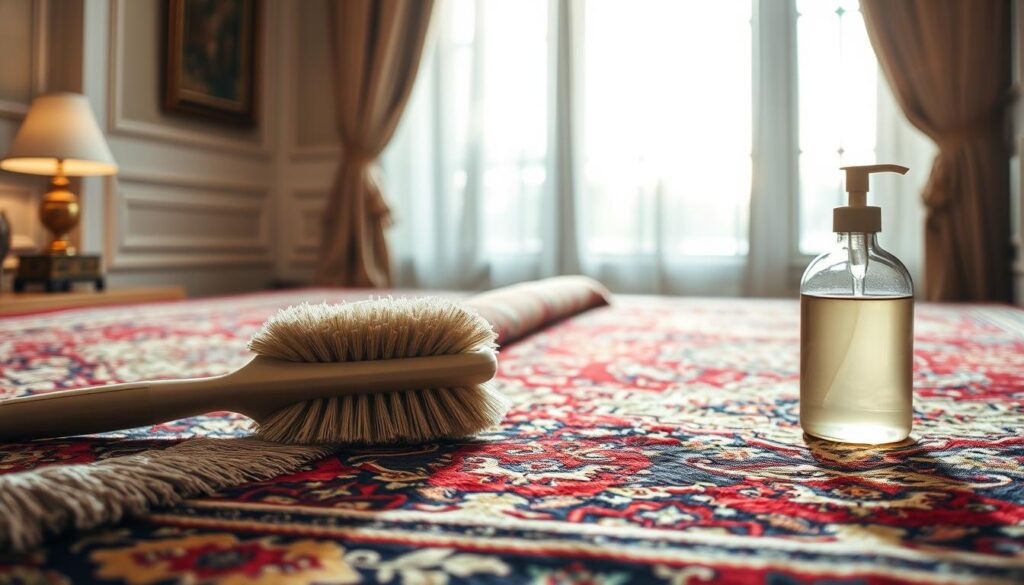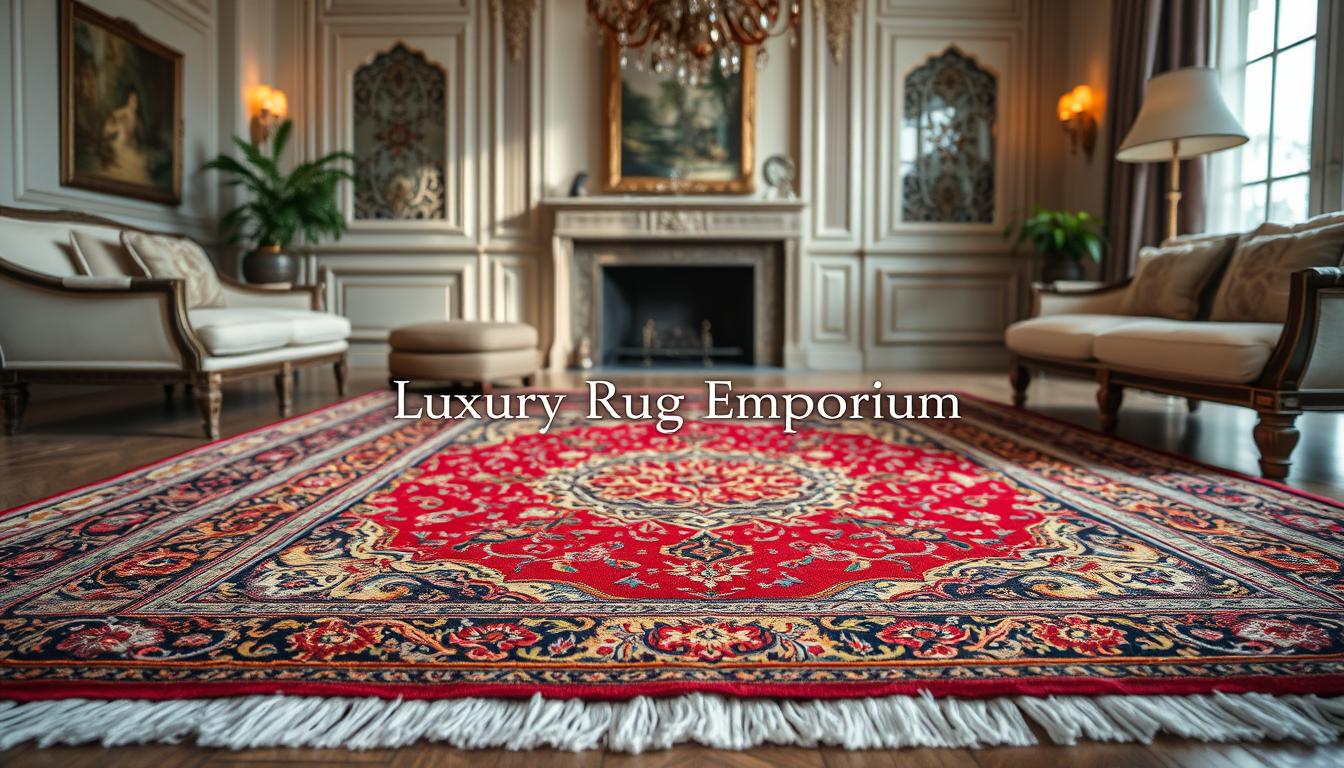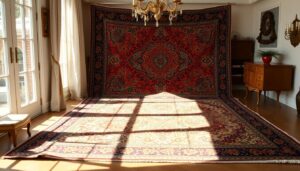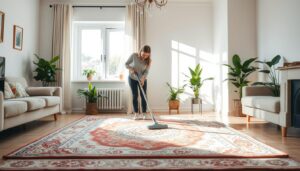Persian and Oriental rugs are highly valued in interior design for their beauty and cultural importance. They can also increase in value over time. If you’re thinking about buying a handwoven rug, you might wonder if it’s a good investment. The answer depends on the rug’s unique qualities and its potential as an investment.
Key Takeaways
- Persian rugs can retain their value over time, unlike machine-made rugs which tend to lose value once used.
- Each hand-knotted Persian rug is a unique piece of art, making them more valuable as investments compared to mass-produced alternatives.
- Factors such as the quality of materials, design, and condition of the rug can significantly impact its investment potential.
- Proper care and maintenance are crucial to preserving the value of a Persian rug over the years.
- Investing in Persian rugs can provide a sense of security as their value often appreciates, unlike money sitting in a bank account.
The Timeless Appeal of Persian Rugs
Persian rugs have been a key part of interior design for a long time. They have a rich history, dating back to the Fifth Century B.C. These handwoven pieces have decorated the floors of European royalty and luxury homes. They have also been seen at high-fashion events, showing their timeless elegance.
Elegance and Cultural Significance
Persian rugs are not just beautiful; they carry deep cultural meaning. The detailed patterns and bright colours show the skill and artistry of generations. Each rug, with its unique designs, brings a story to a space, adding history and sophistication.
Relatively Low-Priced Art Form
Persian rugs are a more affordable way to own a piece of cultural heritage. This makes them popular among homeowners and collectors. They can be the focal point of a room or a subtle addition, bringing luxury and cultural value to any home.
“Persian rugs found popularity in the 20th Century, with instances like Paul Poiret’s ‘Thousand and Second Night’ ball in 1911 and their influence on fashion trends in the ’60s and ’70s.”
Cost of Materials and Labour: Driving Up the Value
Thinking about getting a Persian or oriental rug? It’s key to know the rising costs. The price goes up because of quality materials and skilled labour. These elements make these rugs true works of art.
Rising Expenses for Quality Materials
Premium materials like wool, silk, and natural dyes are used in authentic Persian rugs. As demand grows, so do prices. The cost of top-grade wool and silk fibres keeps going up. This adds to the value of Persian rugs.
Scarcity of Skilled Weavers
Hand-knotting Persian rugs needs a lot of skill and training. But, as Iran’s economy grows, fewer skilled weavers join the craft. This shortage makes Persian rugs more valuable.
| Material | Cost Increase | Impact on Rug Prices |
|---|---|---|
| Wool | 15% over the past 3 years | Significant rise in rug pricing |
| Silk | 20% over the past 5 years | Substantial increase in luxury rug costs |
| Natural Dyes | 25% over the past 7 years | Noticeable impact on high-end rug values |
The cost of persian rug materials and the lack of skilled weavers raise the investment value of Persian and oriental rugs. These factors make buying a high-quality, handmade persian rug a smart long-term choice.
Easy to Pass Down to Next Generation
Investing in Persian rugs has a special advantage. You can easily give them to your children. No paperwork or title transfer is needed. This makes your investment a treasured family heirloom for future generations.
Persian rugs last a long time, keeping their value and beauty. They are different from machine-made rugs, which lose their shine and worth. A handcrafted Persian rug stays valuable and meaningful as it passes through the family.
Being able to pass down Persian rugs as intergenerational investments shows their lasting appeal. These family heirlooms are not just beautiful and historic. They also connect your family to its past, sharing your love for these unique pieces with others.
Gift a Persian rug to your kids or grandkids, or keep it for yourself. The ease of rug inheritance makes them a unique investment. By buying a Persian rug, you get a beautiful piece and a legacy that will last forever.
Investing in a Persian, oriental, or handwoven rugs, is it worth it?
Investing in Persian, oriental, or handwoven rugs can be a smart move. But, it’s important to think it through. These beautiful rugs might grow in value, but there are risks too. It’s best to value their beauty, craftsmanship, and cultural importance more than just their money value.
One big plus of a Persian rug is its lasting value. Made with top materials like wool or silk, they can last for ages. As skilled weavers and rare materials become rarer, these rugs’ value will likely go up, making them a good long-term investment.
Handwoven rugs are special because each one is unique. Their rarity can make them more valuable. But, always buy a rug because you love its look and cultural value, not just for the money.
Looking at an oriental rug as an investment? The rug’s material quality, knot density, and condition matter a lot. Rugs from famous workshops or tribes that don’t exist anymore are especially valuable because they’re getting rarer.
In short, investing in Persian, oriental, or handwoven rugs can be rewarding. But, it’s all about finding a balance. Buy a rug you truly love and think about it as a long-term investment. This way, you can enjoy its beauty and potential financial gain.
“A quality Persian rug is not just a floor covering, but a work of art that can appreciate in value over time.”
Authenticity: Buying from Reputable Dealers
Buying an authentic Persian rug is a big deal. It must be hand-knotted in Iran to be genuine. Rugs made elsewhere or by machines are not real. Look for a dealer with a certification and good reviews to ensure you get a real one.
Certification of Authenticity
A good dealer will give you a certificate of authenticity. This proves the rug was made in Iran by hand. It’s important because authentic rugs keep their value over time.
Long-Established Businesses with Positive Reviews
Choose dealers with years of experience and great feedback. They know how to find and sell real, high-quality rugs. Check online reviews to find trustworthy dealers.
Buying from a trusted dealer means you’re sure about your rug’s authenticity and value. Focus on dealers with certifications and a solid reputation. This way, you invest in a piece of art that will last.
Condition and Material Quality
Investing in Persian or oriental rugs means looking at their condition and material quality closely. Choose rugs that are in top shape, with no repairs or damage. High-quality natural fibres like wool or silk are best. They feel luxurious, hold dye well, and last long.
Excellent Condition with No Repairs
Persian rugs in perfect condition are the most valuable. They show no signs of wear and have been well-kept. Rugs with repairs are less valuable, as even the best fixes can lower their worth.
High-Quality Natural Fibres
The materials used in a Persian rug are key to its value. Wool or silk rugs are most sought after. They last longer and look better than synthetic fibres. These materials make the rug a smart investment.
| Rug Material | Durability | Dye Absorption | Investment Value |
|---|---|---|---|
| Wool | Excellent | Excellent | High |
| Silk | Excellent | Excellent | Very High |
| Synthetic | Poor | Average | Low |

Focus on rugs with excellent condition and natural fibres for a solid investment. This approach is key for building a valuable collection or making a smart choice.
Design and Rarity: Factors Affecting Value
Persian or oriental rugs are loved for their timeless beauty and cultural importance. Their intricate designs also play a big role in their value. The patterns, colours, symmetry, and lack of flaws all add to their worth.
Artistic and Unique Designs
Rugs with rare designs are highly sought after. They often have detailed motifs, bright colours, and exceptional craftsmanship. The more unique and artistic a rug is, the more its value can grow.
Pieces from Famous or Extinct Workshops
Rugs from famous or extinct workshops are very valuable. These persian rug design treasures are rare and show the history of Persian rug-making. They are highly sought after by rug rarity fans and can fetch high prices.
In the world of unique patterns and rug value appreciation, design and rarity matter a lot. Whether it’s a masterpiece or a rare piece from a famous workshop, these rugs are a great investment. They offer a chance to own a piece of timeless beauty and cultural heritage.
Proper Care and Maintenance
Looking after your Persian or Oriental rug is key to keeping it in top shape. Regular vacuuming, rotating it, and getting it professionally cleaned are all important. These steps help your rug stay beautiful for a long time.
Vacuum your rug carefully to avoid damaging it. Rotating it helps it wear evenly, making it last longer. Also, getting it cleaned by experts can keep your rug looking great and its colours bright.
When you’re not using your rug, make sure it’s stored right. The wrong storage can harm it from moths. Good storage keeps your rug safe when it’s not on show.
Persian and Oriental rugs are made from top-quality materials like wool, silk, or cotton. With the right care, they can be enjoyed by many families. They keep their beauty and cultural value for years.
“The oldest surviving carpet in the world is Persian, dating back approximately 2400 years. With proper care, your rug can be cherished for generations to come.”
Key Tips for Caring for Persian and Oriental Rugs:
- Vacuum regularly using suction only to prevent wear and tear
- Rotate the rug periodically to ensure even wear
- Schedule professional cleaning by experienced rug specialists
- Store the rug properly when not in use to protect against moth damage
- Treat stains and damage immediately to maintain the rug’s condition

By following these tips, you can keep your Persian or Oriental rug in great condition. This way, you can enjoy its beauty for many years.
Investment Risks and Realities
Persian rugs can be a great investment, but there are risks to consider. The price you pay at retail is often higher than what you can sell it for at wholesale. This can affect how much profit you make.
Also, even top auction houses can get the rug’s value wrong. About 30% of rugs don’t sell for the expected price. This makes it hard to count on making money from your investment.
Retail vs Wholesale Pricing
The prices for Persian rugs can vary a lot. Retail prices are usually higher than wholesale. This makes it tough to get your money back when selling.
Auction House Estimates Often Inaccurate
Even the best auction houses can’t always guess the rug’s value right. Around 30% of rugs don’t meet the expected price. This shows the risks of investing in rugs.
Persian rugs can add value to your collection, but you need to know the risks. Understanding price differences and auction house estimates helps. This way, you can make better choices and have realistic hopes for your investments.
Tips for Investing in Rugs
Investing in Persian or oriental rugs can be rewarding. But, you need to know the market well and predict what collectors will like. By keeping up with trends and getting advice from rug dealers, you can make a good investment.
Predicting Shifting Collector Tastes
The value of Persian rugs can change as what collectors like changes. To stay ahead, watch the market closely. Look for designs, regions, or weavers that will be in demand soon. The quality of materials, patterns, and how rare the weavers are can affect a rug’s value.
Seeking Guidance from Knowledgeable Dealers
Working with trusted rug dealers is very helpful. They know a lot about authentic, high-quality rugs. They also know about current trends and what rugs might be worth more in the future. Their advice can help you make better choices and increase your chances of a good investment.
| Rug Type | Knot Count | Typical Price Range |
|---|---|---|
| Traditional City Rugs (e.g., Kermans, Isfahans, Qums, Kashans) | 200-800 knots per square inch | £5,000 – £50,000+ |
| Tribal Rugs | 80-200 knots per square inch | £500 – £10,000 |
| Machine-made Rugs | 80-120 knots per square inch | £100 – £1,000 |
By knowing what makes Persian rugs valuable and getting advice from dealers, you can do well in rug investing. This way, you can make choices that could lead to good returns.
Conclusion
Investing in Persian, oriental, or handwoven rugs can be a smart move. It needs careful thought and a love for their beauty and cultural value. There are risks, like market changes and price issues. But, top-quality Persian rugs can grow in value and become treasured family pieces.
Buying from trusted sellers, checking the rug’s condition and material, and knowing about design and rarity can help. This way, you boost your chances of a good investment. These rugs are not just valuable; they also help keep Persian rug-making traditions alive.
Whether or not to invest in these rugs depends on your interests, financial plans, and love for their craftsmanship and cultural importance. Weighing the pros and cons helps you choose wisely. This choice should fit your investment goals and lifestyle.
FAQ
What are the key differences between hand-knotted Persian rugs and machine-made rugs in terms of investment value?
Persian rugs can keep their value over time. Machine-made rugs, however, tend to lose value once used. This is because Persian rugs are handmade, making each one unique. Machine-made rugs can be made in bulk, which lowers their value.
What makes Persian rugs a valuable investment compared to other art forms?
Persian rugs have decorated homes for centuries, making them timeless. They are also a more affordable art form to invest in. Adding a Persian rug to your home brings elegance and cultural significance, making it a valuable addition.
What factors are driving up the value of Persian rugs?
The cost of materials and labour for Persian rugs is increasing. Wool and silk, key materials, are getting pricier. Fewer skilled weavers are available as Iran develops. This scarcity and rising costs make high-quality Persian rugs a smart investment.
What are the advantages of investing in Persian rugs as a family heirloom?
Persian rugs are easy to pass down to future generations. You can gift one to your children without needing paperwork. This makes Persian rugs a valuable family heirloom.
What are the key considerations when investing in a Persian rug?
When investing in a Persian rug, check its authenticity, condition, and material quality. Look for a rug made in Iran, in great condition, and from high-quality natural fibres. The rug’s design, colour, symmetry, and rarity also impact its value.
What are the risks and realities to consider when investing in Persian rugs?
Persian rugs can be a valuable investment, but there are risks. Buyers often pay retail prices but may only sell at wholesale. Auction house estimates are often off, with about 30% of rugs not selling at the reserve price. These factors make it hard to profit reliably from Persian rug investments.
What tips can help investors make successful Persian rug investments?
To make a successful rug investment, stay informed about collector tastes and seek dealer advice. Rug market trends can shift, and knowing which designs or regions will be more valuable is key. Working with reputable dealers who offer expertise can also increase your chances of success.




